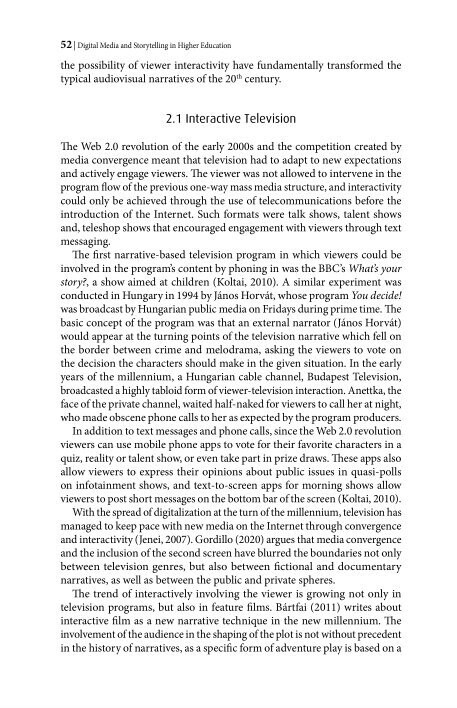

OCR
52 | Digital Media and Storytelling in Higher Education the possibility of viewer interactivity have fundamentally transformed the typical audiovisual narratives of the 20" century. 2.1 Interactive Television The Web 2.0 revolution of the early 2000s and the competition created by media convergence meant that television had to adapt to new expectations and actively engage viewers. The viewer was not allowed to intervene in the program flow of the previous one-way mass media structure, and interactivity could only be achieved through the use of telecommunications before the introduction of the Internet. Such formats were talk shows, talent shows and, teleshop shows that encouraged engagement with viewers through text messaging. The first narrative-based television program in which viewers could be involved in the program's content by phoning in was the BBC’s What's your story?, a show aimed at children (Koltai, 2010). A similar experiment was conducted in Hungary in 1994 by Janos Horvat, whose program You decide! was broadcast by Hungarian public media on Fridays during prime time. The basic concept of the program was that an external narrator (Janos Horvat) would appear at the turning points of the television narrative which fell on the border between crime and melodrama, asking the viewers to vote on the decision the characters should make in the given situation. In the early years of the millennium, a Hungarian cable channel, Budapest Television, broadcasted a highly tabloid form of viewer-television interaction. Anettka, the face of the private channel, waited half-naked for viewers to call her at night, who made obscene phone calls to her as expected by the program producers. In addition to text messages and phone calls, since the Web 2.0 revolution viewers can use mobile phone apps to vote for their favorite characters in a quiz, reality or talent show, or even take part in prize draws. These apps also allow viewers to express their opinions about public issues in quasi-polls on infotainment shows, and text-to-screen apps for morning shows allow viewers to post short messages on the bottom bar of the screen (Koltai, 2010). With the spread of digitalization at the turn of the millennium, television has managed to keep pace with new media on the Internet through convergence and interactivity (Jenei, 2007). Gordillo (2020) argues that media convergence and the inclusion of the second screen have blurred the boundaries not only between television genres, but also between fictional and documentary narratives, as well as between the public and private spheres. The trend of interactively involving the viewer is growing not only in television programs, but also in feature films. Bartfai (2011) writes about interactive film as a new narrative technique in the new millennium. The involvement of the audience in the shaping of the plot is not without precedent in the history of narratives, as a specific form of adventure play is based on a
Strukturell
Custom
Image Metadata
- Bild Breite
- 1831 px
- Bild Höhe
- 2835 px
- Bild Auflösung
- 300 px/inch
- Dateigröße
- 1.31 MB
- Permalink zum JPG
- 022_000040/0052.jpg
- Permalink zur OCR
- 022_000040/0052.ocr
Benutzeranmeldung
Deutschde
